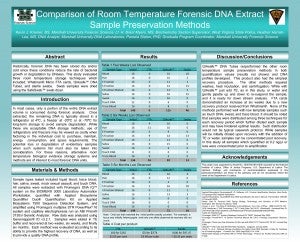Comparison of Room Temperature Forensic DNA Extract Sample Preservation Methods
Biography:
Kevin Kramer is from Delphos, OH. He graduated from The University of Findlay in 2008 where he received a Bachelor’s degree in Forensic Science with an emphasis in DNA and Serology and minors in Biology and Chemistry. Kevin is currently a graduate student at Marshall University where he is studying Forensic Science with emphases in DNA analysis, forensic chemistry, computer forensics, and crime scene investigation. This summer, Kevin his completed internship at the Marshall University Forensic Science Center evaluating room temperature storage methods of DNA extracts for the West Virginia State Police.
Abstract:
In most cases, only a portion of the entire DNA extract volume is consumed during forensic analysis. Once extracted, the remaining DNA is typically stored in a refrigerator at 4ºC, a freezer at -20ºC or at -70ºC for long-term storage to avoid sample degradation. While these are acceptable DNA storage methods, use of refrigerators and freezers may be viewed as costly when factoring in the individual cost to purchase and maintain as well as energy and space requirements. The potential loss or degradation of evidentiary samples when such systems fail must also be taken into consideration as well as when refrigeration and/or freezers are not readily available. For these reasons, alternative room temperature biological evidence storage systems and methods are of interest to most forensic DNA units. This study evaluated three room temperature storage techniques which included; Whatman® Micro FTA cards, QIAsafe™ DNA Tubes, and sterile swabs. Swab samples were dried using the SafeSwab™ swab dryer, and a contamination study was conducted to ensure that the drying process would not cause cross contamination. All samples were extracted with Promega’s DNA IQ™ system on the BIOMEK® 3000 Laboratory Automation Workstation, quantified with Applied Biosystems Quantifiler Duo® Quantification Kit on Applied Biosystems 7500 Sequence Detection System, and amplified using Promega’s multiplex STR PowerPlex® 16 system and capillary electrophoresis run on ABI Prism® 3130xl Genetic Analyzer. Raw data from the 3130xl was analyzed using Genemapper® ID v3.2.1.
Poster:
References:
- Applied Biosystems Genemapper® ID Software v3.2.1-Human Identification Analysis, User Guide, © Copyright 2003 Applied Biosystems.
- Applied Biosystems, Quantifiler® Duo DNA Quantification Kit-User’s Manual, Part Number 4391294 © Copyright 2008.
- Crowe, J. et al. The Role of Vitrification in Anhydrobiosis. Ann. Rev. of Phys. 1998 Oct;60:73-103.
- GE® Healthcare, FTA® Technology. FTA™ Cards Data File 51613. Whatman®. Accessed May 20, 2010 from http://www.whatman.com/References/FTA%20CardsDataSheet%20FINAL%203.25.10%20LR.pdf.
- Promega’s DNA IQ™ System-Database Protocol PN TB297, Revised May 2009.
- Promega’s PowerPlex™ 16 System Technical Manual No. D012. Promega Corporation, Madison, WI.
- Promega’s Tissue and Hair Extraction Kit (for use with DNA IQ™) Protocol PN TB 307, revised May 2009.
- QIAsafe™ DNA Tube and 96-Well Plate Handbook. Qiagen®, January 2008.
- Smith, S., et al. Optional Storage Conditions for Highly Dilute DNA Samples: A Role for Trehalose as a Preserving Agent. J Forensic Sci. 2005 Sept;50(5):1101-1108.
- Whatman® Storage of Purified DNA on FTA® Technology. Protocol for Purified Genomic DNA on FTA®.
